Reference: "Machine Learning"
principle
sample n-dimensional Gaussian distribution is:

Σ is the covariance matrix
By the Bayes' theorem, the sample belonging to class i Xj posterior probability is:
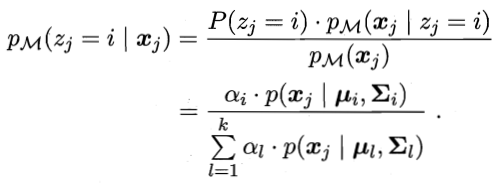
The abbreviated formula for the gamma] JI
The formula for the sample Xj Category

Each classification to a coefficient, using the log-likelihood, have
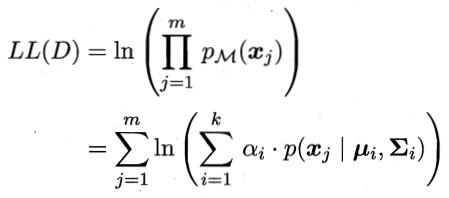
Derivative of the above formula were Σ, μ, so the derivative is 0, to give


Summing coefficient is 1, this constraint is introduced, in the form of log likelihood Lagrangian is

The coefficient α of the derivative of formula, so the derivative is 0, to give

Above, red frame part is the parameter update formula, particularly relates to a derivative of the scalar vector / matrix derivation, generally Differentiation Method, your own Now derivation rules.
Algorithmic process is:
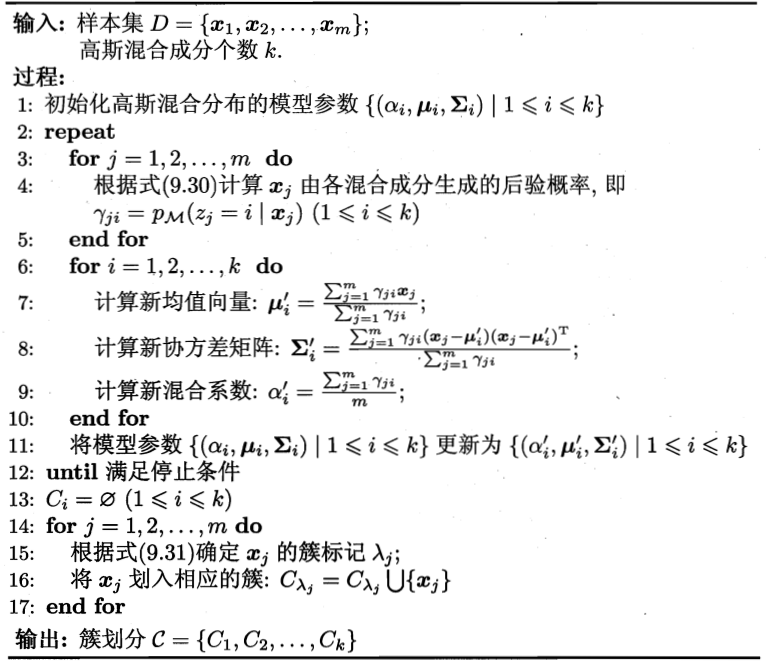
Implementation code:
data set
4.0 watermelon data set using, as follows
序号,密度,含糖量
1,0.697,0.460 2,0.774,0.376 3,0.634,0.264 4,0.608,0.318 5,0.556,0.215 6,0.403,0.237 7,0.481,0.149 8,0.437,0.211 9,0.666,0.091 10,0.243,0.267 11,0.245,0.057 12,0.343,0.099 13,0.639,0.161 14,0.657,0.198 15,0.360,0.370 16,0.593,0.042 17,0.719,0.103 18,0.359,0.188 19,0.339,0.241 20,0.282,0.257 21,0.748,0.232 22,0.714,0.346 23,0.483,0.312 24,0.478,0.437 25,0.525,0.369 26,0.751,0.489 27,0.532,0.472 28,0.473,0.376 29,0.725,0.445 30,0.446,0.459
代码
# 1 读取数据
file='xigua4.txt'
x=[]
with open(file) as f:
f.readline()
lines=f.read().split('\n')
for line in lines:
data=line.split(',')
x.append([float(data[-2]),float(data[-1])])
y=np.array(x)
# 2 算法部分
import numpy as np
import random
def probability(x,u,cov):
cov_inv=np.linalg.inv(cov)
cov_det=np.linalg.det(cov)
return np.exp(-1/2*((x-u).T.dot(cov_inv.dot(x-u))))/np.sqrt(cov_det)
def gauss_mixed_clustering(x,k=3,epochs=50,reload_params=None):
features_num=len(x[0])
r=np.empty(shape=(len(x),k))
# 初始化系数,均值向量和协方差矩阵
if reload_params!=None:
a,u,cov=reload_params
else:
a=np.random.uniform(size=k)
a/=np.sum(a)
u=np.array(random.sample(list(x),k))
cov=np.empty(shape=(k,features_num,features_num))
# 初始化为只有对角线不为0
for i in range(k):
for j in range(features_num):
cov[i][j]=[0]*j+[0.5]+[0]*(features_num-j-1)
step=0
while step<epochs:
# E步:计算r_ji
for j in range(len(x)):
for i in range(k):
r[j,i]=a[i]*probability(x[j],u[i],cov[i])
r[j]/=np.sum(r[j])
for i in range(k):
r_toal=np.sum(r[:,i])
u[i]=np.sum([x[j]*r[j,i] for j in range(len(x))],axis=0)/r_toal
cov[i]=np.sum([r[j,i]*((x[j]-u[i]).reshape((features_num,1)).dot((x[j]-u[i]).reshape((1,features_num)))) for j in range(len(x))],axis=0)/r_toal
a[i]=r_toal/len(x)
step+=1
C=[]
for i in range(k):
C.append([])
for j in range(len(x)):
c_j=np.argmax(r[j,:])
C[c_j].append(x[j])
return C,a,u,cov
验证
res,A,U,COV=gauss_mixed_clustering(y)
import matplotlib.pyplot as plt
%matplotlib inline
colors=['green','blue','red','black','yellow','orange']
for i in range(len(res)):
plt.scatter([d[0] for d in res[i]],[d[1] for d in res[i]],color=colors[i],label=str(i))
plt.scatter([d[0] for d in U],[d[1] for d in U],color=colors[-1],marker='^',label='center')
plt.xlabel('density')
plt.ylabel('suger')
plt.legend()
50轮后

# 100轮
res,A,U,COV=gauss_mixed_clustering(y,reload_params=[A,U,COV])
for i in range(len(res)):
plt.scatter([d[0] for d in res[i]],[d[1] for d in res[i]],color=colors[i],label=str(i))
plt.scatter([d[0] for d in U],[d[1] for d in U],color=colors[-1],marker='^',label='center')
plt.xlabel('density')
plt.ylabel('suger')
plt.legend()
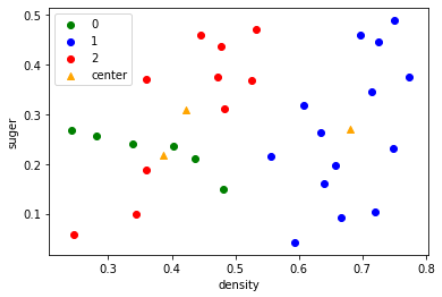
# 200轮后不再变化
res,A,U,COV=gauss_mixed_clustering(y,epochs=100,reload_params=[A,U,COV])
for i in range(len(res)):
plt.scatter([d[0] for d in res[i]],[d[1] for d in res[i]],color=colors[i],label=str(i))
plt.scatter([d[0] for d in U],[d[1] for d in U],color=colors[-1],marker='^',label='center')
plt.xlabel('density')
plt.ylabel('suger')
plt.legend()
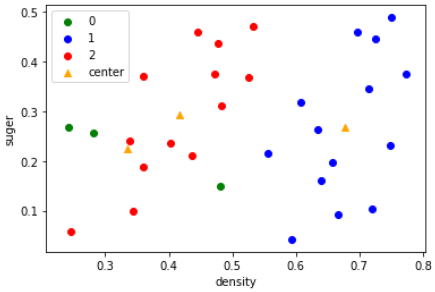
总结
这个算法本身不复杂,可能涉及到矩阵求导的部分会麻烦一点。西瓜数据集太小了,收敛非常快。然后,这个算法同样对于初值敏感。